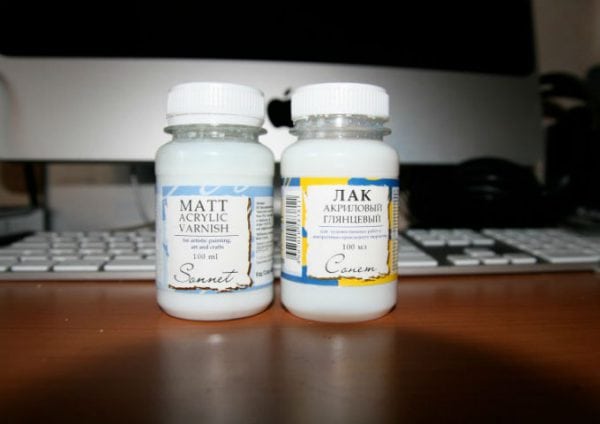On glass surfaces, varnishing is most often used as a decorative layer, as well as to protect other paint solutions applied to glass, for example, paints. The same product is applicable for decorative ceramic work. The protective coating must be moisture and heat resistant, resistant to ultraviolet radiation.
Interact well with glass and ceramic surfaces. Perhaps create an additional decorative effect. Glass varnishes are used in the production of stained glass window products and mirrors, interior items made of glass and ceramics, glass elements of various devices and devices, glass containers and so on.
Typically, finished products already have a protective coating, made in a production environment. But if you want to decorate your stained glass window profile, mirror, door glass inserts and ceramics yourself, you have such an opportunity.
Paints and varnishes for glass ceramics
For example, acrylic water-soluble varnish on a polyurethane basis for glass work, forms a decorative coating with high physical and mechanical stability indicators. The original solution is transparent or translucent. Almost no odor. Fireproof, well laid down. After application, it dries up within one and a half to two hours at a temperature of +60 degrees. The polymerization period depends on the temperature and humidity. So at room temperature, complete curing will occur within 3-4 days.
Acrylic waterborne varnish can be applied to the glass of interior doors, electric lighting devices, interior elements, ceramic products, tiles as a decorative protective coating. Also, the solution is applicable as a temporary protection of the glass surface during transportation, sandblasting, thermal, water transfer, ultraviolet printing, with multi-layer staining.
It can be used as a finishing layer for fixing the picture and as a primer (when using thermal transfer technology, for example).
From the positive characteristics of the protective coating, we highlight:
- environmental safety (because water);
- water resistance;
- good adhesive properties;
- wear resistance;
- hardness;
- transparency without yellowness;
- preservation of color saturation of the decorative finish (pattern).
The first time after application, a whitish-milky hue appears in the solution. But after drying, the varnish will be completely transparent (no clouded glass or a faded pattern).
The coating has an unusual decorative property - a frosty effect is created in the sandblasted drawings. The treated surface becomes glossy, shiny, light-scattering. Acrylic varnishes allow the use of decorative additives - the effect of mother of pearl, the effect of metallic, the effect of a hologram. The pigment substance is introduced into the composition of the solution immediately before work according to the mixing proportions indicated on the package.
“Frost effect” is also a type of paint and varnish materials for coating glass products.As a result of processing, a frosty or frosted effect is resistant to abrasion. In this case, the frosty effect can easily be made not only traditional white, but also any shade of color (due to a special pigment additive). Drying technology involves firing. At home, this is possible in a conventional oven (half an hour at a temperature of +180 degrees).
It is more convenient to distribute the solution over the glass using a spray gun. Then the coating lays more evenly, without streaks and sagging. But you can also apply such solutions with a brush, using for painting small drawings. Manufacturers of paints and varnishes marked "stained" have achieved such a uniform consistency that when looking at the lumen there were no random smears - as if colored glass inserts.
For spot applications, such as ceramic or tile coatings, it is better to use a coating varnish fixative. The substance is resistant to various external influences, even washing ceramic products in a dishwasher.
For industrial use, more aggressive solutions are used, for example, based on epoxy resins. This coating has high chemical resistance and abrasion resistance. Special stained glass lacquer is added when staining glass containers, including perfume bottles, in the decorative finish of glass-ceramic products. Note that the word "stained glass" in the name of the product directly indicates the possibility of using coatings for any type of glass ceramics.
If processing of glass and ceramic surfaces is required in rooms with high humidity or constant exposure to organic solvents, stained glass varnish can be found for these purposes. The main property of such products is increased mechanical strength and chemical resistance.
Special transparent glass lacquer is not necessary to use only as a decorative topcoat to protect the drawings. After varnishing, the base material itself becomes more resistant to mechanical stress.






“Achieved such uniformity of consistency that when looking at the lumen there were no random smears” (c)
Just add thixotropins to the varnish ... I use them when painting with water urethanes for leather, car interiors, bags and furniture, etc. Thixotropins-thickeners prevent smudges on vertical surfaces. And give a perfectly smooth surface.
How it works can be seen in colors from Tikkurila-Ipair and Maalarin Valkalakka.